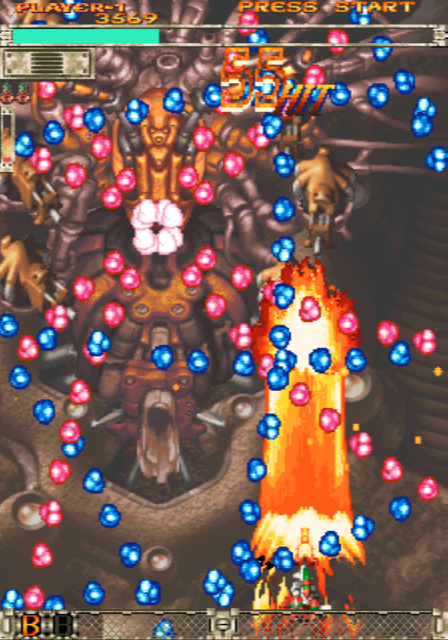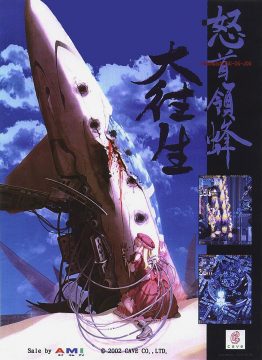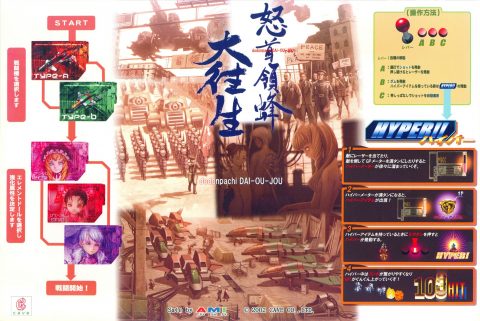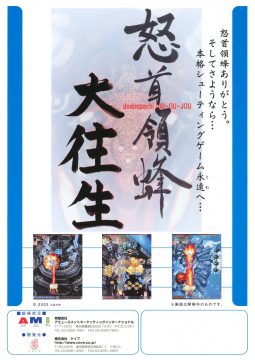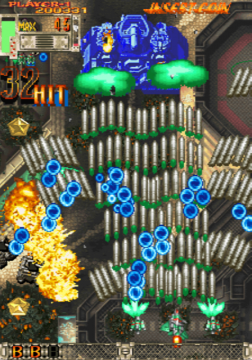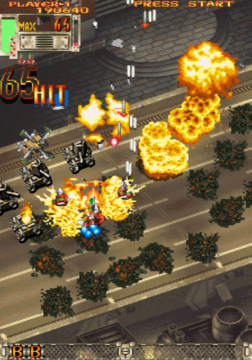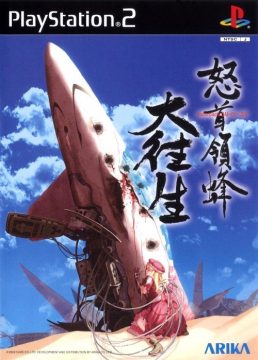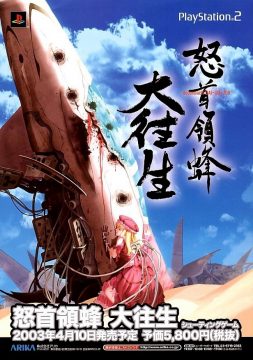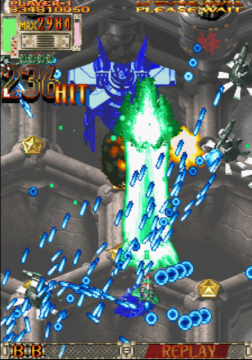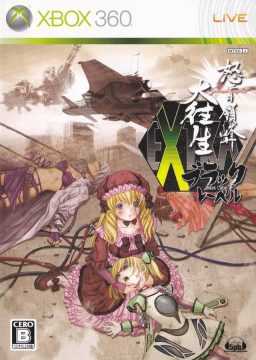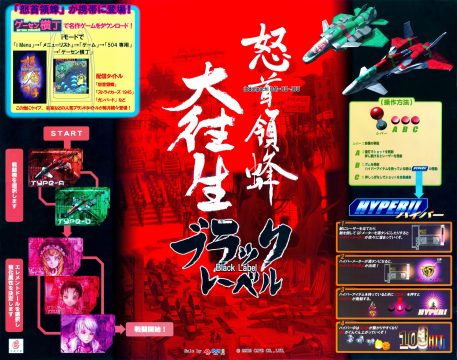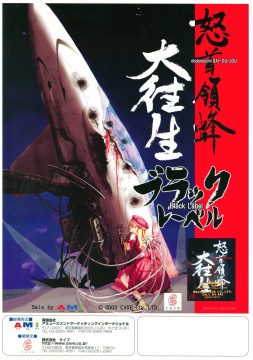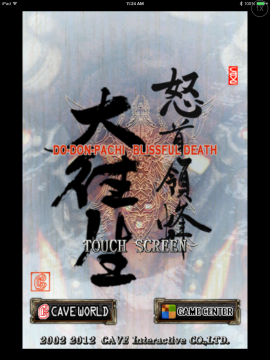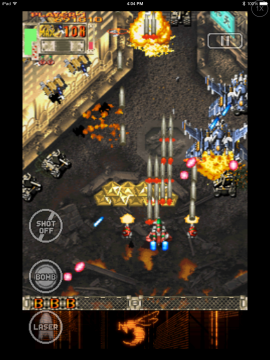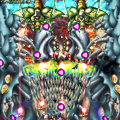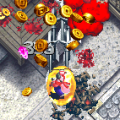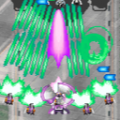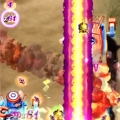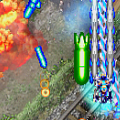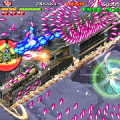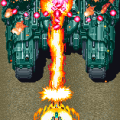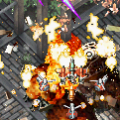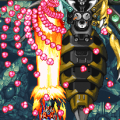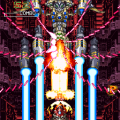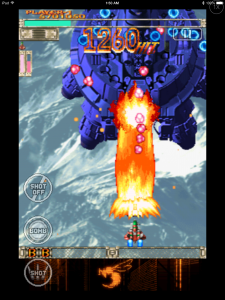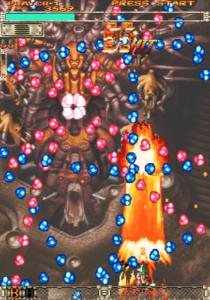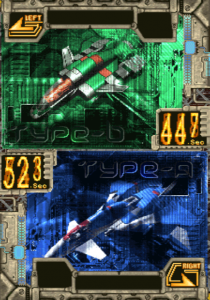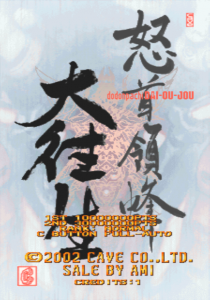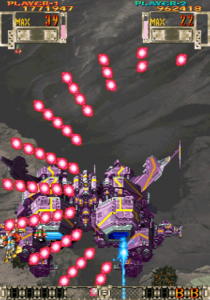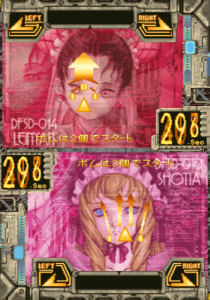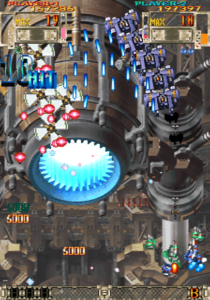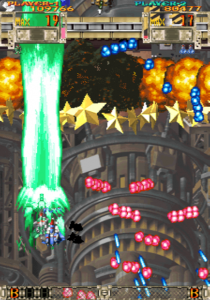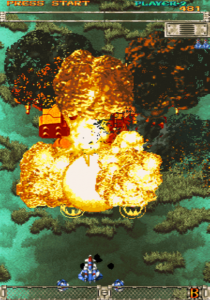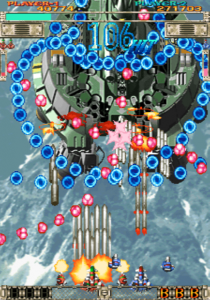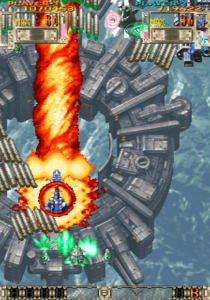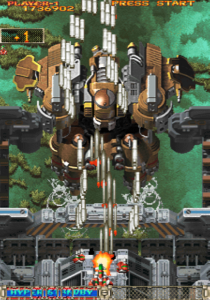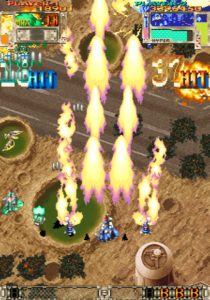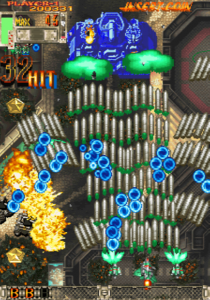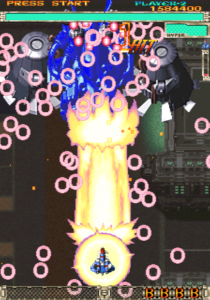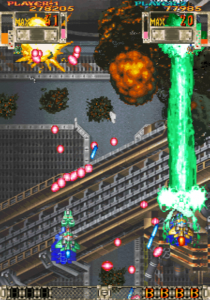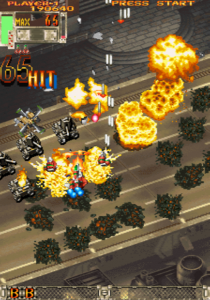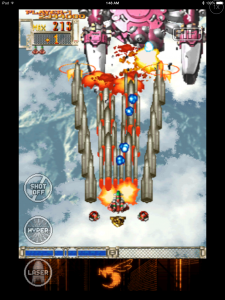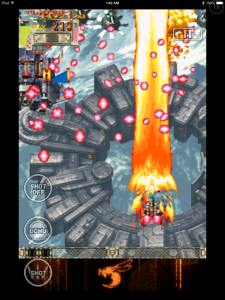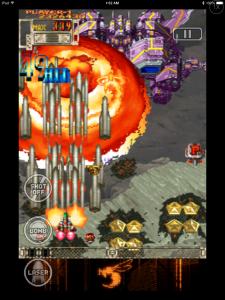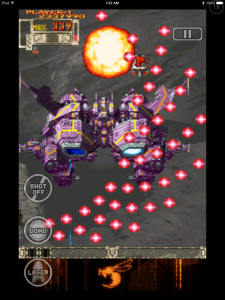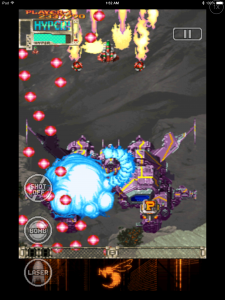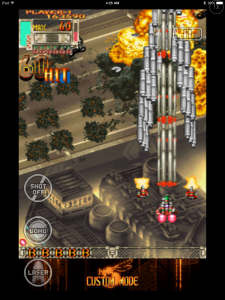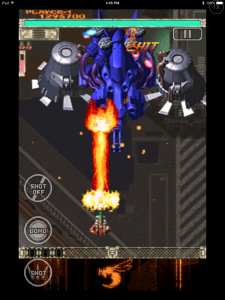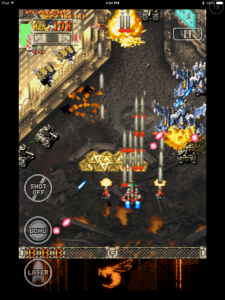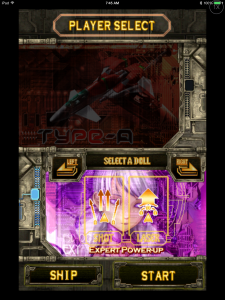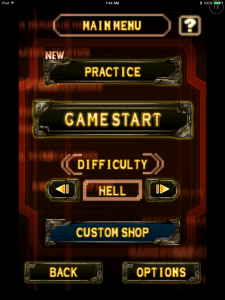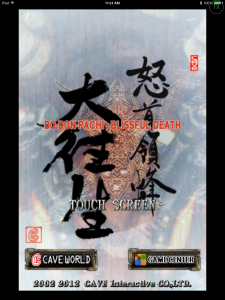“Daioujou Suru Ga Yoi (Die A Blissful Death)”
When Dodonpachi was released, it had a tagline telling players that “dying is good” (shinu ga yoi). Cave must have truly believed that line, because on April 5, 2002 Cave released the next game in their DonPachi series titled: Dodonpachi Daioujou (lit. “Angry Leader Bee Blissful Death”). The game ran on the PolyGame Master hardware, just like Dodonpachi II Bee Storm did, which ran at relatively low specs compared to other hardware at the time. If weak hardware wasn’t enough the game was developed on a ridiculously tight schedule by a small development team. When all three factors were combined with the team working with Cave’s flagship franchise, Dodonpachi, the team was under intense pressure the entire time. In fact, at one point game’s development team was told that Cave’s arcade development division would be disbanded if the game didn’t perform well at its location tests! But Cave’s fans are a passionate bunch, and because of their support, Daioujou was released successfully, allowing many gamers to experience the “blissful death” for themselves.
Story
Daioujou‘s story begins one thousand years after the events of Dodonpachi (Dodonpachi II Bee Storm‘s events are non-canon). After being betrayed by the leader of the Donpachi Squadron, a lone pilot managed to defeat Colonel Schwarlitz Longhena’s mechanized army, and prevent his plan to annihilate the human race from succeeding. However many lives had been lost due to this battle, cities were razed and weapons were destroyed. Ironically, the war had also solved the problems of overpopulation, pollution, and the growing arms race. In order to preserve the newfound peace, humanity sealed what remained of the Colonel’s robot army on the moon, hoping that such an event would never occur again. Humanity would slowly begin to rebuild and after one thousand years, civilization was at last used for peace. In this age, humans had gone on to colonize the moon itself, using advanced robotics that were capable of completing tasks that proved too challenging for human comprehension.
Suddenly, a disturbance on the moon was reported. The exiled machines had reawakened, quickly overtaking the defenseless Lunapoils, and creating automated production facilities for their army. Intercepting information that the awakened machine army was currently rebuilding Hibachi in preparation to attack Earth and fulfil their original programmed goal: the annihilation of the human race. With little time to spare, the United Nations ordered the reactivation of the Donpachi Corps. However, what time mankind had was few, with only enough to produce two types of ships to combat an army, let alone produce pilots of equal caliber to those of the legendary Donpachi Corps. To make up for this shortcoming, the ships were equipped with an “Element Doll”: artificial life forms who have been specially modified to optimize a ship’s destructive power, allowing the craft to operate at an enhanced level. However, here a contradiction emerged. Once more humanity was committing the same mistake: a war of machine against machine…
Knowing that the mission is suicidal, the ships are deployed on the surface of the moon, alone against the mechanized army. They have but one objective: Kill.
Characters
DFSD-010 “Shotia”
An Element Doll that enhances the fighter’s Shot. She is programmed to be faithful and pure, and has little concept of emotion, often bearing a rather cold expression. She starts with, and can carry, the largest amount of bombs in the game.
DFSD-014 “Leinyan”
An Element Doll that enhances the fighter’s Laser. She has been intentionally programmed to protect “humanity”. However, when she was activated a glitch occurred in her system that converted the “humanity” she was to protect, to the pilot of her ship. As such, her internal temperatures seem to rise when she thinks of him.
FSD-002 “Exy”
An Element Doll that enhances both the fighter’s Shot and Laser capabilities. Exy is an older-generation doll, and was designed to maximize a fighter’s functionality, with no regards to pilot safety. Due to her programming, she is the preferred Element Doll for advanced pilots. Exy starts out with a single bomb, and can carry two at most.
Gameplay
Dodonpachi Daioujou is a three button game (two buttons, one auto-fire button), with the same controls as the previous games. Daioujou has a very different style than the other DonPachi games, going for a dark sci-fi look. The game has a really cool (and detailed) Nixie tube style throughout its UI. Cave even put the inactive numbers as darker, but still visible pixels, further simulating the Nixie tube styling. It’s a very nice touch that really adds to the overall feel of the game. During gameplay, the scoring information can be found in the upper left corner of the screen, which contains the GPS system, the combo gauge, and the new Hyper System, in addition to their score and remaining ships. Getting high chains and point-blanking enemies will raise the Hyper Gauge, which, when full, will cause a Hyper Medal to drop from the top of the screen. After collecting a Hyper Medal, pressing the B button will cancel all bullets on screen and cause the player’s ship to gain devastatingly powerful Shot and Laser weapons for a limited time. The time remaining for the Hyper is shown below the GPS bar. Pressing the B button again during a Hyper will cause a Spread Bomb or Laser Bomb to go off, canceling the rest of the Hyper. Keep in mind that using either type of bomb will end the player’s current chain.
In Daioujou, players can only choose from two ship types: the red Type-A ship and the green Type-B ship. The Type-A ship remains pretty much the same as it has been in the previous DonPachi games, a fast red ship whose shot fires straight ahead. The Type-B ship retains its wider shot area than the Type-A ship, but its options have changed from previous incarnations. Before, the angle of the Type-B ship’s options could be manually rotated by moving the joystick right or left, but now, in Daioujou, its options are now fixed at an angle similar to the Type-C ship’s options (when paired with Shotia or Exy). Depending on the Element Doll selected, the angle of the ship’s Shot will change. Selecting Shotia will cause the player’s ship to move even slower when using the laser. If players select Leinyan, their options will circle around the front of the ship, firing in front of the ship (the Type-B ship’s angle is wider than the Type-A’s). Selecting Shotia or Exy, however, will cause the Type-A’s options shot to widen, though it will still be more narrow than the Type-B ship’s Shot while using Leinyan. The Type-B ship’s movement is also slower than the Type-A ship, in addition to having a weaker shot than the Type-A. The hitbox for both ships is the pilot’s cockpit, with the Type-A ship’s cockpit positioned closer to the tip of the ship than the Type-B hitbox. The number of bombs a player has is not ship dependent, rather it is determined by which Element Doll is selected plus the number of deaths the player incurs.
Weapon power-ups in Daioujou are the same as they were in Dodonpachi, in addition to the new Hyper Medal. Star score items return, with the small and ground stars now worth 500 points each, a new medium sized star worth 5,000 points and the large stars being worth 10,000 points apiece. Additionally, each stage contains 10 hidden bee items, which now have an increased importance in Daioujou‘s scoring, and as such, will be detailed in that section of the article. Dying in Daioujou causes the weapon type of their Elemental Doll to decrease by one level, with the other weapon reverting back to level 1. The player will also gain a bomb stock each time they lose a life (unless they are in Hyper Mode) until they reach their maximum capacity, which again, depends on what Element Doll the player is using.
Daioujou keeps the chaining system from Dodonpachi, and is used in scoring and building Hyper Gauge. The Hyper system is a new attack system used in Dodonpachi Daioujou. The Hyper Gauge is the pink vertical gauge to the right of the GPS, and filling this gauge up 100% will cause every bullet on the screen to become a small star item, and causes a Hyper Medal to drop from the top of the screen. Players can store up to five of these Hyper Medals at a time. When a player has at least one Hyper Medal, pressing the B button will use all of the stored Hyper Medals and cause the player to enter into Hyper Mode. Activating Hyper Mode will cancel all bullets onscreen, and give the player a very brief period of invincibility. While Hyper Mode is active, the player’s hit count will increase very rapidly (as does a player’ score), in addition to gaining very wide and powerful Shot and Laser weapons. Players can see how much time is remaining by the looking at the green bar underneath the GPS. The strength and duration of Hyper Mode is dependent on the number of Hyper Medals the player held before entering. There are some downsides to Hyper Mode, as the speed and quantity of enemy bullets will increase dramatically while Hyper Mode is active. The effect is increased depending on what level of Hyper was used. When Hyper Mode ends, the bullet density and speed will slow down, but still be at a value higher than it was before the Hyper. The enemy bullets will remain this way until the player dies or uses a bomb. Hyper Mode will end if a player gets hit, uses a bomb, or the lets the Hyper Mode timer run out. Players will lose any Hyper Medals they had stocked if they lose a life.
Every time the player completely fills the combo timer to its maximum will award increase the Hyper Gauge, with higher chains awarding more meter. Hitting a boss with the Laser will also fill the Hyper Gauge. Players will instantly receive 30% of a full Hyper Gauge upon losing a life. The final way to fill the Hyper Gauge is to collect a bee item while having at least a 20-HIT chain. Collecting a bee item with a 20 to 39 hit chain will fill 3% of the Hyper Gauge, having a 40 to 59 HIT chain will give 6%, and so on until the player has a 200+ HIT chain, which fills 30% of the Hyper Gauge. However, collecting a bee item while in Hyper Mode will award very little if any Hyper Gauge at all. Using Hyper Mode while a Hyper Medal is on the screen will cause it to transform into a large star item. When a Hyper Gauge is filled to 100%, the remaining amount is not rolled over, and any extra meter is lost, rather than filling into the next gauge. During boss battles, filling a Hyper Gauge will still cause every bullet on screen to become a small star item, but the Hyper Medal will appear unless the player bombs, or dies. Players can cancel a Hyper by using a bomb, provided they have one available.
Dodonpachi Daioujou also has a hidden ranking system, one that makes the game harder as the rank increases. Luckily, rank is only increased by using Hypers, and the amount it increases is proportional to the level of Hyper used. Rank can only be decreased by bombing or losing a life. Because of the increase in speed and quantity in enemy bullets (and the ranking system), it is advised to never use a Hyper higher than level 2 on bosses, as the difficulty increase far outweighs the reward. Therefore, it is better to just use multiple level one Hypers, rather than one large level 5 Hyper.
Daioujou contains a hidden second loop, which can be accessed by completing the five stages in the first loop, and successfully meet one of the following requirements: the player has died less than two times, the player has used less than three bombs, or players have collected the x2 bee in at least three stages. If a player is successful in accessing the second loop, they are in for even more “blissful death”. Daioujou‘s second loop is just like the first loop, except everything has been jacked way up. For starters, the second loop is harder, much harder, with denser bullet patterns, and more aggressive enemies; but, the second loop also features a massively increased scoring potential. Here’s an example of the increased scoring potential: if a player no miss no bombed the first loop, they end up with about 30 million extra points. If players have MAXIMUM at the start of the second loop, they start earning around 1 million points every two seconds! At the end of the first loop, if the requirements for the second loop have not been met, the extra ships in a player’s stock are added to their score at 10 million points each. However, if the player does make it to the second loop, the extra ships are still taken away, meaning players will start the second loop with just one life. Players can receive an extra life for every stage that they complete, as well as the hidden 1Up in the fourth stage. At the end of the fifth stage in the second loop, players will go on to face a resurrected Taisabachi, and the game’s True Last Boss: Hibachi. All extra ships at the end of the second loop are worth 50 million points each. One last thing about the second loop: if a player runs out of lives during the second loop, they are sent straight to the game over screen, players cannot continue, nor can other players join the game during the second loop.
Scoring
As in the previous DonPachi games, scoring in Daioujou is all about achieving and properly maintaining a high combo chain. Every enemy in Daioujou has a base point value attached to it, and destroying that enemy in a chain will add their point value multiplied by the number of hits in the chain to the total score. Bees play an important role in Daioujou, and are worth 1,000 points multiplied by the number of hits in the current combo chain. Uncovering a bee item with the Laser will add a HIT to the current combo chain, and it will refill the combo timer when an item is collected. If a player can collect all ten bee items in a stage without dying, the last item will have an additional x2 multiplier. Collecting all the bee items in a stage will also increase their default value by 1,000 for every subsequent stage. Collecting every bee item in both loops will cause the bee items to be worth 10,000 points each in the final stage! Since enemies and bees can become worth major points, in addition to the fact that collecting bees with a high chain is the fastest way to fill the Hyper Gauge. Successfully destroying bosses give a boss hit bonus, which is found by taking the stage number plus 2 multiplied by 100,000 points, with the resulting value being multiplied by the result of the number of hits on the boss counter plus one divided by 200. Finally, while not that important in the first loop, having a maximum bonus in the second loop can provide an incredible amount of points. If a player can no miss no bomb the entire second loop, players can earn more than 450 million points! To score in Daioujou, players will need to learn where to be at all times, routing a path that will allow them to collect all ten bees, maintain a single combo chain throughout the entire the stage, all while dodging the onslaught of enemy bullets. Utilize level one Hypers, and utilize the bullet canceling enemies and events (Hyper Mode item creation or activation) to the player’s advantage. It won’t be an easy task, but it’s what is required if players want to survive Daioujou.
Music
The amount of instruments the arcade hardware could use was the same number as the Super Nintendo, with the added caveat that everything had to fit on a single floppy disk. Dodonpachi Daioujou‘s tracks (which are all named after different shooting game companies) still sound great, with a musical selection that features many different styles, yet don’t feel out of place while playing. Daioujou‘s music was composed by Manabu Namiki, who would go on to do the music for Ketsui, Mushihimesama, and numerous other games. The tracks of Daioujou are mixed bag, often featuring an oriental vibe, the music seems to change styles with each stage, while keeping the genre staples of electro and synth. Each track sounds great, and really capture the essence of a stage, but a few just sound absolutely incredible. The first incredible track comes in the first stage, giving off a very oriental vibe, and sounds a bit too similar to Mushihime-sama Futari Stage 5 music (which was also composed by Namiki). Another standout track is “Sakusetsu”, Stage 4’s groovy industrial track that just seems to get more and more chaotic as it goes on, much like the stage itself. When players reach the final boss, the music takes a sudden tonal shift, doing a great job at creating the sense of dread and awe that Taisabachi commands. Then comes the final track that plays while fighting the game’s True Last Boss: Hibachi. When fighting against Hibachi, everything feels fast. This is likely due to Cave wanted to have Hibachi’s attacks sync up with the music, which for some reason, is set to a blazing 200 bpm. Featuring a very simple melody of single hit notes, a constant rhythm of sixteenth notes, and a backbeat that just won’t quit, “Hidou” is one hell of a rush that manages to perfectly capture what a True Last Boss battle should be about. Overall Daioujou‘s music is better than most shmups, with a very wide musical range that supplements the whole experience, never feeling out of place.
Final Thoughts
Dodonpachi Daioujou is hard. The game starts off somewhat easy, but quickly ramps up to a brutal difficulty designed to instill panic in inexperienced players, sending them to their “blissful death”. It’s that difficulty barrier that will ultimately turn off most players. Being able to 1CC Daioujou is quite an accomplishment, one that not many people can do. The in-game music is really good all things considered, but it sounds best on the official OST, where it is now in stereo, and without the limitations of the PolyGame Master hardware. Players can credit-feed through the game, but it gets so chaotic in the later levels that unless someone knows what to do and where to be, players lose all of their lives again in a matter of minutes. The game can still be enjoyed by new players, just be prepared; Dodonpachi Daioujou only wants to be played a certain way, and dishes out heavy punishment to those who don’t.
Dodonpachi Daioujou (怒首領蜂 大往生) – PlayStation 2 (April 10, 2003)
Dodonpachi Daioujou was a big hit in the arcades, and would receive a lovingly crafted port to the PlayStation 2 by developer Arika. Arika actually brought in some of Dodonpachi Daioujou‘s top super players such as Clover-TAC and KTL-NAL. The game released with an included high score DVD containing four super plays by four different super players (including Clover-TAC and KTL-NAL). The PlayStation 2 version of the game is based on the original, “White Label” version of Daioujou, despite coming out months after the Black Label version of the game.
Port Features
The PlayStation 2 port of Dodonpachi Daioujou features the standard Arcade Mode, a very detailed training mode dubbed “Simulation Mode”, and Death Label, a boss rush mode exclusive to this port. In addition to the multiple gameplay modes, the port also includes a gallery mode containing multiple pieces of both concept and promotional art for Daioujou. Despite the lack of an Arrange Mode, the game includes an arranged BGM option. Players can switch between the game’s original BGM and the new arranged BGM via an option in the main menu. Players can also change their button configuration, and turn the Yoko map display and background wallpapers on or off. Finally the port supports display in both Yoko and Tate modes, with the Tate mode capable of running at 15 kHz 224×448 resolution, the same as the the actual hardware.
Arcade mode has its own set of options, with difficulty, starting ships, and the score at which extends are given. The Arcade Mode itself is very faithful to the original Arcade version of Daioujou, featuring about 90~95% slowdown accuracy. The Arcade Mode also contains a unique mode called No Bullet Mode. In No Bullet Mode, enemies cannot fire any bullets, but the player can, making it incredibly easy to say the least. It sounds silly, but No Bullet Mode actually has its uses, such as learning enemy placement for chaining, bee locations, and seeing the second loop and Hibachi. Both modes offer the ability to save replays that can viewed later in the Simulation Mode.
The Simulation Mode included in Daioujou‘s PlayStation 2 port is incredible, and sets a very high bar that all shmups should strive to include. Players of course have the standard options of ship type and stage selection, but the port really goes above and beyond with its numerous amount of additional options. Players can choose to start their session from the beginning of the stage or right at the boss. Players are given the ability to recreate almost any situation they have encountered, by being able to set their rank, power, if they are hypering, how much hyper is remaining, how many times they have hypered, the number of bombs, the MAXIMUM Bonus, and more. There is also an option to save their settings and load them for later use. Players can also watch replays of their previous runs in Simulation Mode, with the option to override the replay and begin playing the game themselves at any time. Probably the coolest feature of the whole game can be found in the Simulation Mode. In addition to Super Replays. The Super Replay is a set of pre-loaded replays using the Type-B Laser ship and covers each stage for both loops. Like the normal replay mode, players can take control and override the Super Replay at any time during its run.
Death Label
The third gameplay mode, Death Label, is a two loop boss rush mode, and may just be one of the hardest video-game modes ever created. In this mode, players are constantly at maximum power, and begin each fight with a full stock of bombs, lives, and hypers, and they’ll need every one, as the bosses use the second loop shot patterns during the first loop of Death Label. If a player makes it all the way to the fifth stage, and manage to defeat the boss, they will have an encounter with Taisabachi, and besting him will put the player against not one, but two Hibachis, the TLB of Daioujou. Players who triumph over the two Hibachis are treated to a bit of story by way of a cut scene from ol’ Colonel Schwarlitz Longhena himself, revealing that he is the mastermind behind the events of Death Label. And if that wasn’t enough, the game features a second loop, where the bosses have newer, harder patterns, no initial hypers, and Laser Bombs heal the bosses. Oh, and they have to do all of this on ONE life. One miss, one hit, and it’s an instant Game Over. But! The game isn’t impossible, as on September 18, 2010, seven years after its initial release, a player named MON became the first person to clear this hellish mode. A link to his incredible feat can be found in the link section below, and is a must watch.
Final Thoughts On The Port
It’s a true shame that this port was never released outside of Japan, as MON’s seven-year long quest to conquer Death Label shows that this port offers many, many years’ worth of gaming. If players want to import the game, they should be aware that the game is region-locked to Japan, and can only be played on a Japanese PlayStation 2. The game plays great, and with its faithful Arcade Mode, incredible Simulation Mode, brutal Death Label Mode, arcade-perfect graphics, and newly arranged soundtrack, is a very worthy port to one of the hardest shmups ever made.
Dodonpachi Daioujou Black Label (怒首領蜂 大往生 ブラックレーベル) / Dodonpachi Daioujou Black Label EXTRA (怒首領蜂 大往生 ブラックレーベル EXTRA) – Arcade, Xbox 360 (October 25, 2002)
Black Label Overview
Dodonpachi Daioujou is a good, yet incredibly difficult game, but it had some issues. Issues that kept bothering main programmer Tsuneki Ikeda after the game was released. At the same time, Cave was receiving a number of complaints from both players and arcade operators, suggesting various ways to adjust and improve Daioujou that Ikeda had previously not thought of. So, all by himself, he started working on this “ideal, fixed version” of Daioujou. This new version addressed all the issues Ikeda had with the original game, plus some of the fixes suggested by the players themselves. During Ketsui‘s development, Ikeda had an idea for a scoring contest in the Arcadia magazine, with the winner receiving a board containing Ikeda’s custom Daioujou. It was at this time he decided to include the original Daioujou in addition to the special version on the same board. When he felt it was ready, he presented his version to the higher-ups, with hopes of distributing it, they responded with “we should sell this thing!” And that’s how Daioujou Black Label was created, not for money, but because it was something Ikeda wanted to make. The game would be released as a very low production run, with only 100 copies being made, with an enhanced Xbox 360 port of the game developed and published by 5pb nearly seven years later.
Gameplay Differences
Dodonpachi Daioujou Black Label made a number of changes, but two of them stand out the most. The first major change is the ability to choose a one or two loop game after the selection screen. If players select a one loop game, they will automatically face Taisabachi and Hibachi after finishing Stage 5. Players no longer lose their extra lives and bombs when starting the second loop. Players can now continue while in the second loop, making it possible to credit-feed through and see all of the harder patterns, as well as Hibachi himself. Many players feel that the game’s Hyper Gauge now fills faster than before, and this is true only because it wasn’t working properly in the original version. Before, if a player picked up a bee icon worth 30% Hyper while at 99% full Hyper Gauge, they would gain 129% Hyper, enough to generate an item. However, the extra 29% did not carry over to the new bar, and was just thrown away. In Black Label, that extra 29% is now properly carried over into the next Hyper bar. The rank increase from Hypering has also been reduced, with the maximum cap itself also being raised. Because extra lives are now kept during the loop, and the increase in Hypers, both difficulty and bullet speed rank systems now behave a little differently than before. These subtle changes actually lead to the second major change in Black Label, which is that the first loop has become easier, with slower bullets and smaller patterns, while the second loop’s difficulty has been increased in Black Label. Some visual bugs were fixed as well, such as the counter only being able to display four digits, and would roll over if it exceeded 9999 HITs. Additionally, the chaining system is slightly less strict than before.
Characters
PFSD-015 “Piper”
An Element Doll that generates more hyper items for the fighter. She is a prototype for a planned mass-production run of Element Dolls. As such, her programming is rather incomplete, only learning how to smile when after observing her pilot. Piper has the shortest hyper duration of the Element Dolls, and starts off with zero bombs in storage.
Black Label EXTRA
Black Label EXTRA includes the original “White Label” and Black Label versions of Dodonpachi Daioujou, along with an exclusive X-Mode designed for beginner players. The port also features online leaderboards for all modes, the ability to save and watch replays, enhanced graphics, and exclusive Xbox Live content such as gamerpics and achievements. The game can be played in Yoko or Tate mode. Players can also switch between the game’s original audio (in both Mono and Stereo formats) as well as the new arranged soundtrack made for the game’s X-Mode, in all modes of play.
Each game mode has a number of options, usually consisting of 1 or 2 Player game, Record Replay, Xbox Live Game, Stage Select, Game Config, and Game Config EX. 1 or 2 Player game is the same as the arcade version, and allows the players to continue after dying (so long as they have credits). Players start with one credit, and can unlock additional credits by reaching certain levels in the normal game. Record Replay Mode is pretty self-explanatory. Xbox LIVE Game is a Score Attack Mode, where players play through the arcade mode but cannot continue. After the game is over, they can upload their scores and replays to the global leaderboards. Stage Select is the game’s poor attempt at a training mode. Players can only make the most basic of changes before starting, and the plethora of options found in the PlayStation 2 version are nowhere to be seen. Game Config allows the player to alter their button configuration, the difficulty settings, starting ships, and when extends are given out. Game Config EX allows players to alter certain aspects of the game, such as remove the ability to continue, always enter the second loop, No Bullets Mode, alter the duration of the GP meter, Hyper Gauge, remove the bullet limit, and even toggle the wait control (slowdown) on and off through this menu. Most of these additional functions must be unlocked by completing specific achievements or after playing the game for so many total hours.
EXTRA’s X-Mode
X-Mode (also known as an Arrange Mode) was designed to be enjoyed by novice players, so why is this mode only available after six hours of playtime? Regardless, X-Mode features a new Element Doll, gameplay and scoring system, as well as an arranged soundtrack. Gameplay-wise, X-Mode is only one loop across five stages, with the players fighting Taisabachi and Hibachi and the end. The new Element Doll Piper causes both the ship’s Shot and Laser to always be in Hyper Mode, meaning things die very quickly. Piper can still access Hyper Mode just like the rest of the Element Dolls, which is now green, and now has the ability to cancel almost all types of bullets. How bullets can be canceled depends on what Element Doll the player is using. Shotia can cancel bullets with her Hyper Shot, Leinyan can cancel bullets with her Hyper Laser, Exy can cancel bullets with both the Hyper Shot and Hyper Laser, but requires two Hyper items to activate, and Piper can also cancel bullets with her Hyper Shot and Hyper Laser, requires one Hyper item to activate, but has the shortest duration of the bunch. Piper also has her own unique story in X-Mode, complete with her own unique ending…but she doesn’t fare much better than the other Element Dolls. The other Element Dolls have the same endings as the original game, but have undergone a graphical upgrade, and feature spiffy new artwork stills.
Scoring in X-Mode
In X-Mode, enemies are a player’s friend, as they shoot bullets, bullets that players can cancel for points. Each canceled bullet also increases the combo chain by one, making each bullet canceled worth more than the last. Therefore, the optimal way to score big points is to activate Hyper Mode, move the ship to the bottom left or right corners, allowing all sorts of enemies to pass by, but continuing to shoot. The corners may not be the best place to be in all situations, but it is usually the safest, allowing the player to maximize their score with the least amount of risk. There are times when players will want to point-blank certain enemies or boss patterns, to maximize the number of bullets canceled. However, the new green and orange bullets Hibachi fires cannot be canceled. Of course, the chaining system of Daioujou is still present, and as such, players should avoid dropping chains whenever possible for the maximum amount of score. Bee items and such are still present, but the point values for collecting them are dwarfed by the amount gained from canceling bullets.
Music
The arranged music for Black Label EXTRA was arranged by Manabu Namiki and Basicscape, an independent music and sound production company. The new arranged music rides the fine line of remix versus new music very well, as the music is different enough to be new and fresh, while keeping enough of the original track to have a sense of familiarity. The music itself is very diverse, ranging from a very chill main menu and Stage 4 music, a more electronic Stage 1, a very DonPachi Taisabachi track, and much more The new boss battle music, “Burning Body”, for example, starts off with a few seconds of “meh” before hitting the listener hard and doesn’t let up for the rest of the song. It’s a hot chaotic mess of wailing guitars, synth distortions, and heavy drums, with a little vocal sampling thrown in. It’s a great track on its own that really captures the chaos of Daioujou‘s boss battles. And listeners get a sneak preview of what Hibachi’s theme would sound like in the next DonPachi game.
Initial Issues with EXTRA
Black Label EXTRA was plagued with numerous bugs and glitches upon its initial release. It came to the point where 5pb had to publically apologize for releasing the game as it was, and halted the production of any more copies from being made until they fixed the game. An investigation into the matter found that the problems were a result of 5pb taking the source code from directly Arika’s PlayStation 2 port of Daioujou, which was copied and pasted into the Xbox 360 version of the game without permission. This prompted Cave to step in and attempt to fix the game themselves, but the game was such a mess that Microsoft had to intervene and help Cave with the patch’s development. More than a year after its release, the patch was finally complete, making the game both playable and a worthy port of Black Label, featuring an approximate 90-95% slowdown emulation of the arcade game.
Final Thoughts
Black Label set out what it meant to do, fixing a few of the issues from the original Daioujou, while making the game easier for new players. Even though it make the second loop harder, it also made it easier by allowing players to continue if they lost all their lives. Though initially the Xbox 360 port of Black Label was a disaster, the game is very playable now thanks to the patch. X-Mode is a fun distraction, and can be seen as a prototype version of the next DonPachi game, Dodonpachi Daifukkatsu, which features a similar bullet canceling system. That being said, the Xbox 360 version has gotten to be quite pricey, although it’s much less than a Black Label PCB. The game is also region locked to Japan, and can only be played on a Japanese Xbox 360 console. Current versions of MAME do support Dodonpachi Daioujou Black Label, and may serve as the best option for most players who want to experience the game for themselves.
Dodonpachi Daioujou (怒首領蜂 大往生) / Dodonpachi Blissful Death – iOS (February 9, 2012)
Daioujou With New Play Control
In December of 2008, Nintendo released its first game in a special “New Play Control!” series for the Nintendo Wii. The concept of the series was to update a number of Nintendo GameCube games to utilize the Wii’s new motion control capabilities. And that is essentially what Dodonpachi Blissful Death for iOS is: Dodonpachi Daioujou with a new input method. Unlike Resurrection HD, Blissful Death is a rather bare-bones port, only containing the original Arcade mode (but players can continue during the second loop), a Practice Mode, and an interesting Custom Shop. As Blissful Death is mostly a straight port of Daioujou, the game does not feature new HD graphics, but retains the original sprites from the arcade version of the game. The game itself controls just like Cave’s other iOS shmups, which is perfectly fine, as they remain as buttery smooth as ever. Blissful Death also features four levels of difficulty, with the easier levels having less dense bullet patterns.
The port itself is very playable, but the most interesting thing about it is that Custom Shop. The Custom Shop is a series of in-app purchases that exist to enhance or alter the standard gameplay experience and rules. For a price, players can have the option to always travel to the second loop, regardless if the conditions were met or not. Other options include having the bee items visible, though still requiring to be hit by the tip of the Laser, reduce the ship’s hitbox, have the ship’s Shot and/or Laser always start at a certain level, regardless of Element Doll selection, additional lives, bombs, extended combo time and faster Hyper Gauge filling. The game also comes with two custom options unlocked by default: Evade Support (shows the ship’s hitbox), and Mobility Delay. Mobility Delay is an interesting option, as it reduces the ship’s mobility when using the Laser, just like the arcade version. Having any of these options enabled causes the game to enter in “Custom Mode”, meaning that the player is playing with custom options. This is mainly used in the online leaderboards, which feature separate leaderboards for the standard and custom modes. Players also have the option to purchase items from the Custom Shop individually, or bundle them all together at a discounted price.
Final Thoughts on The New Play Control
So, is the game worth it? Yes! Blissful Death is a very playable version of Daioujou, and it’s just as hard. It’s actually the closest to arcade version of Cave’s mobile ports thanks to the optional Mobility Delay when using the Laser. People may not like the Custom Shop, but it’s not required to enjoy the game, and even activating the options is tucked away in a menu located in the bottom right of the main options menu. The Practice Mode isn’t anything special, but it gets the job done. It’s at a much more reasonable price than Resurrection HD, and it should. Players are only getting one gameplay mode, rather than two, and the game is not optimized for tablets, meaning that iPad owners have to play a zoomed in version of the iPod/iPhone game. The game also isn’t in HD, instead just using the same graphics found in the arcade version. That in itself isn’t too bad, but some people may be off put by it.
Links:
Dodonpachi Blissful Death Official Site
Links:
Official Daioujou Site Has tons of neat info in “Stage Enemy List” and “Element Doll”
Detailed DOJ System Guide
DOJ Basics A forum thread covering the basic systems of DOJ
1-ALL Type B playthrough A complete run of the first loop of DOJ
DOJ TLB Hibachi Superplayer ISO faces off against the TLB Hibachi in DOJ
DOJ Playlist on YouTube
DOJ PS2 Superplay A 1CC 2-ALL Clear that is very close to the world record score
Developer Interview An interivew with Arika and several superplayers about the port
MON 1CC Death Label The first person to clear Death Label, which took 7 years
MON-Arika Interview An interivew with MON about his Death Label clear
MON-Gameband Interview Another interivew with MON about his Death Label clear
DOJ Arrange OST Playlist on YouTube
DOJ+Espgaluda – Perfect Remix – OST Playlist on YouTube
Black Label EXTRA Official Site
Black Label differences A thread listing the differences between the “White” and Black Labels
Developer Interview An interview with Ikeda about the creation of Black Label
Special Demonstrations #2 A great 2-ALL Type A-Exy replay by Prometheus
Black Label Technical Guide A technical guide for DOJ BL’s Hyper system
Leinyan EXTRA Arrange A decent quality video showing X-Mode in action.
Piper EXTRA Arrange A short viedo of Piper in action.
DOJ Black Label EXTRA OST Playlist on YouTube
